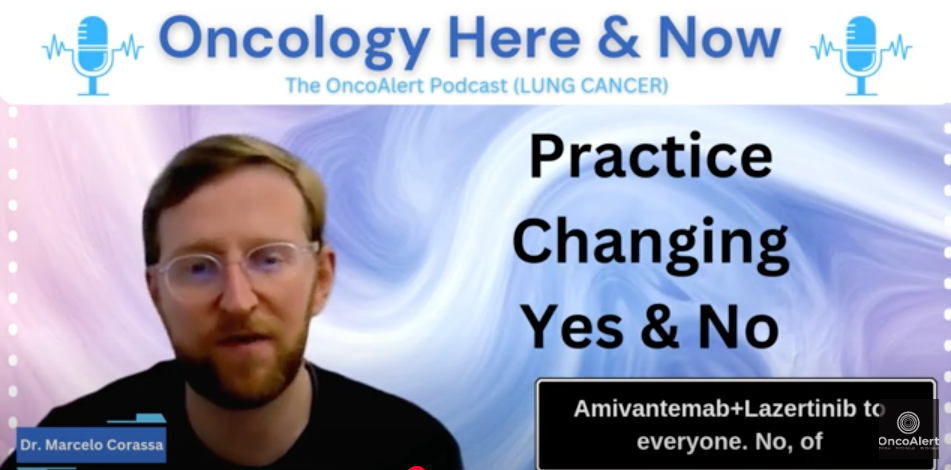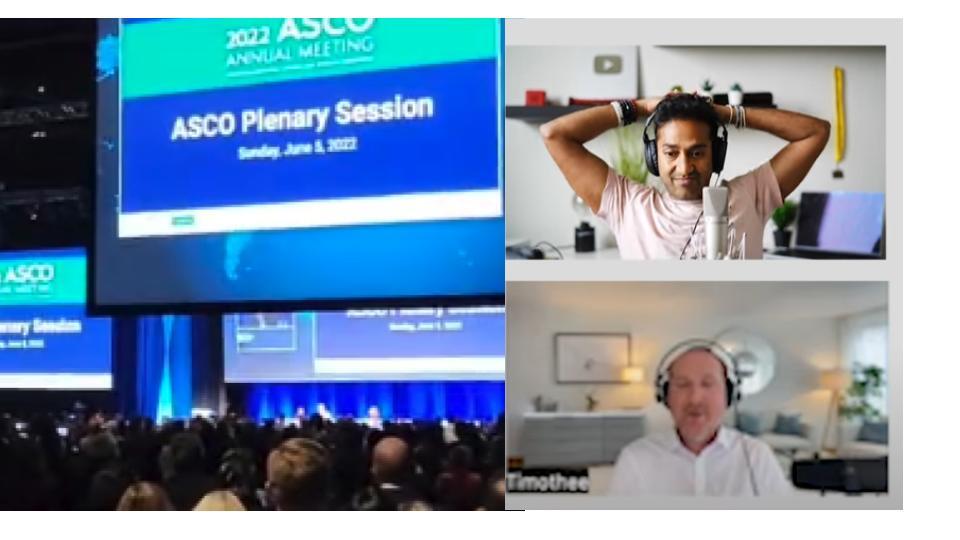4 min read
Lung Cancer KOLs Use Memes to Communicate EGFRmut Treatments
The Role of Memes in Communicating Lung Cancer Treatment Challenges: A Focus on EGFR Mutation Therapy In the realm of healthcare communication,...
4 min read
Brian Shields
:
Apr 22, 2025 7:55:46 AM

In a powerful video discussion with Dr. Biagio Ricciuti, Dana-Farber Cancer Center, Dr. Marcelo Corassa shared an impressive discussion of the MARIPOSA trial from a researcher and clinician's perspective. Unlike many of the canned and boring videos that we see during ASCO and other events where the speakers just rehash the major data points from the plenary presentations, Dr. Corassa really brought a powerful discussion to an extremely important topic: How should patients with advanced EGFRmut NSCLC be treated across the sequence of therapies? Dr. Ricciuti asked very pointed questions and did not interrupt Dr. Corassa during his very poignant discussions. This allowed for some incredible insights from Dr. Corassa regarding the nuances of treating patients with EGFRmut, managing the amivantanab side effects, and the importance of the shared decision making process with patients.
Boom, this was probably not the answer that the Rybrevant Marketing Team wanted to hear. Dr. Corassa did a great job reviewing the importance of the landmark Overall Survival of MARIPOSA trial, and even discussed the plateau of the survival curve which may indicate an immunologic response to the therapy:
However, in the very next sentence, Dr. Corassa shared the reality of the tough decisions that clinicians need to make when choosing the MARIPOSA regimen for their patients. In this clip below, Dr. Corassa not only shares his thoughts about the toxicities of the MARIPOSA regimen, but also shared his experience as a MARIPOSA investigator. This is so unique! Dr. Corassa actually shares that for some patients he hoped that they would be in the control arm, because he was so concerned about the toxicity management of Deep Vein Thrombosis and infusion reactions. This is a very personal, and powerful clip, and very rare in today's world of video production sets and KOLs in suits giving voice overs on slides.
There is currently a great unknown in the world of advanced EGFRmut NSCLC treatment. The current standard of care has been single agent osimertinib. This was the comparator arm in the MARIPOSA trial, and the amivantanab + lazertinib arm demonstrated at least a 1 year survival advantage over this single agent therapy. However, as Dr. Corassa noted, there are toxicities, and other researchers have noted, time toxicities, and an increase in cost, "financial toxicitiy". So is FLAURA2 the answer? The FLAURA2 trial has demonstrated an improvement in Progression Free Survival for osimertinib + chemo, versus single agent osimertinib. Clinicians and researchers are currently awaiting the Overall Survival data for FLAURA2. Dr. Corassa seems optimistic about the OS data for FLAURA2, but he does discuss the comparison of curves, ie. the "plateau" effect seen in MARIPOSA survival vs the eventual FLAURA2 Kaplan Meier curve. In this context, Dr. Corassa shared a very insightful discussion demonstrating the art of medicine where data exists in this grey area. Below he shares his experience using the FLAURA2 regimen, dropping the chemo component and then using amivantamab + chemo as second line therapy. This is an interesting perspective as he's sharing his experience as a clinician, not just a "talking head" reiterating data from slides.
Dr. Corassa reviewed many different patient types and his treatment recommendations for tailoring therapies based on he individual patient needs. This really is an amazing discussion. He touched upon age and frailty. biomarkers and mutations, brain metastasis, symptomatic disease, worse prognosis, etc. Dr, Corassa shared that he relies on three main factors when tailoring the right therapy for the patients:
Below is a table with time stamps of the various patient discussions that he shared with Dr. Ricciuti.
| Discussion on Patient Selection | Timestamp |
|---|---|
| "If you have an 85 year old patient who is very frail, you don't have to think about TP53, you don't have to think about RB1..." | Link to Timestamp |
| "You have a patient with brain mats. I do think that intensification plays a major role in brain mats." | Link to Timestamp |
| "Worse prognosis. So if I have a patient who is very symptomatic, brain, brain mats, lung mats, bone mass, liver mats..." | Link to Timestamp |
| "If you have a patient with a very low burden of disease, EGFRXo19 deletion plus TP53..." | Link to Timestamp |
| "But if you have a patient, you see that patient, this is a high risk patient, the patient is not doing good." | Link to Timestamp |
| "What do you do for work?... I work as a secretary and I type all the time. Maybe it's going to be very tough for this patient..." | Link to Timestamp |
| "If you have a patient with an amplification in EGFR for maybe this patient is ideal for amivantanab..." | Link to Timestamp |
Dr. Corassa's ability to express the importance of data based decisions along with his shared decision making discussions with patients makes this video a must-see for any fellow in training today. It's very clear that Dr. Corasso values his experience and conversations with other researchers like Dr. Dr. Biagio Ricciuti, enjoys educating other doctors through his story-telling approach throughout the video, and most importantly, you can see that he values his time with patients as he shares experiences of patient success stories and shared decision-making discussions.
Below are some other key quotes from this discussion
| Statement | Timestamp |
|---|---|
| "And I always say to my patients that the honeymoon tends to end." | Link to Timestamp |
| "...meaningful gain in overall survival, it's actually impressive." | Link to Timestamp |
| "The toxicity is, is crazy. I, I've been an investigator for Mariposa and it's tough." | Link to Timestamp |
| "We should try to pursue a biomarker testing. Ah, but it, it's expensive. I don't have access. The patient doesn't want a biopsy, You have to insist..." | Link to Timestamp |
| "Clinical trial, we have to put patients in clinical trials." | Link to Timestamp |
| "Lastly, I, I think it's that we, we should consider retesting our patients every time." | Link to Timestamp |
| "You should put your patient on a clinical trial, of course." | Link to Timestamp |
| "I have more trouble understanding right now, how we're going to put our patients in first line.. What are we going to choose in second line?" | Link to Timestamp |
ONCOLOGY HERE & NOW PODCAST🎙️
— Gil Morgan, MD (@weoncologists) April 14, 2025
Join Dr. Biagio Ricciuti🇺🇸of @DanaFarber &
Dr. @MarceloCorassa 🇧🇷 of beneficência Portuguesa de São Paulo as they discuss Treatments in EGFR 🧬mutant #NSCLC Non Small Cell #LungCancer 🫁@VJOncology @mirrorsmed @high5md @COR2EDMedEd @wearemedsir https://t.co/67oux3E16o
This is a tweet from Dr. Corassa where he discusses a very helpful slide from an #ASCO24 presentation by Dr. Jessica Lin. This is a great example of how KOLs or DOLs (digital opinion leaders) keep the oncology community both informed and educated on clinical trial data in real-time. It's difficult for folks that are not experts to place clinical trial data releases into perspective. The tweet below and the accompanying slide touch upon the nuances of sequencing that Dr. Corassa mentions in the video discussion above. How do you think the recent MARIPOSA OS data may have changed Dr. Corassa's perspectives from ASCO24?
As KOLs like Dr. Corassa share their insights, as well as the insights of their peers in real-time, they are rapidly advancing medicine, one tweet at a time, one video at a time.
Great slide from @JessicaJLinMD. mPFS wise, I do prefer the balance among efficacy and toxicity. Thus, all the butterflies and related stuff are still, in my perspective, relegated to the post Osimertinib setting. #ASCO24 pic.twitter.com/PGi6uGIhy1
— Marcelo Corassa, MD. (@MarceloCorassa) May 31, 2024

4 min read
The Role of Memes in Communicating Lung Cancer Treatment Challenges: A Focus on EGFR Mutation Therapy In the realm of healthcare communication,...

As Dr. Vinay Prasad takes over the very important Center for Biologics Evaluation & Research at the FDA, It's important to note that this is the...